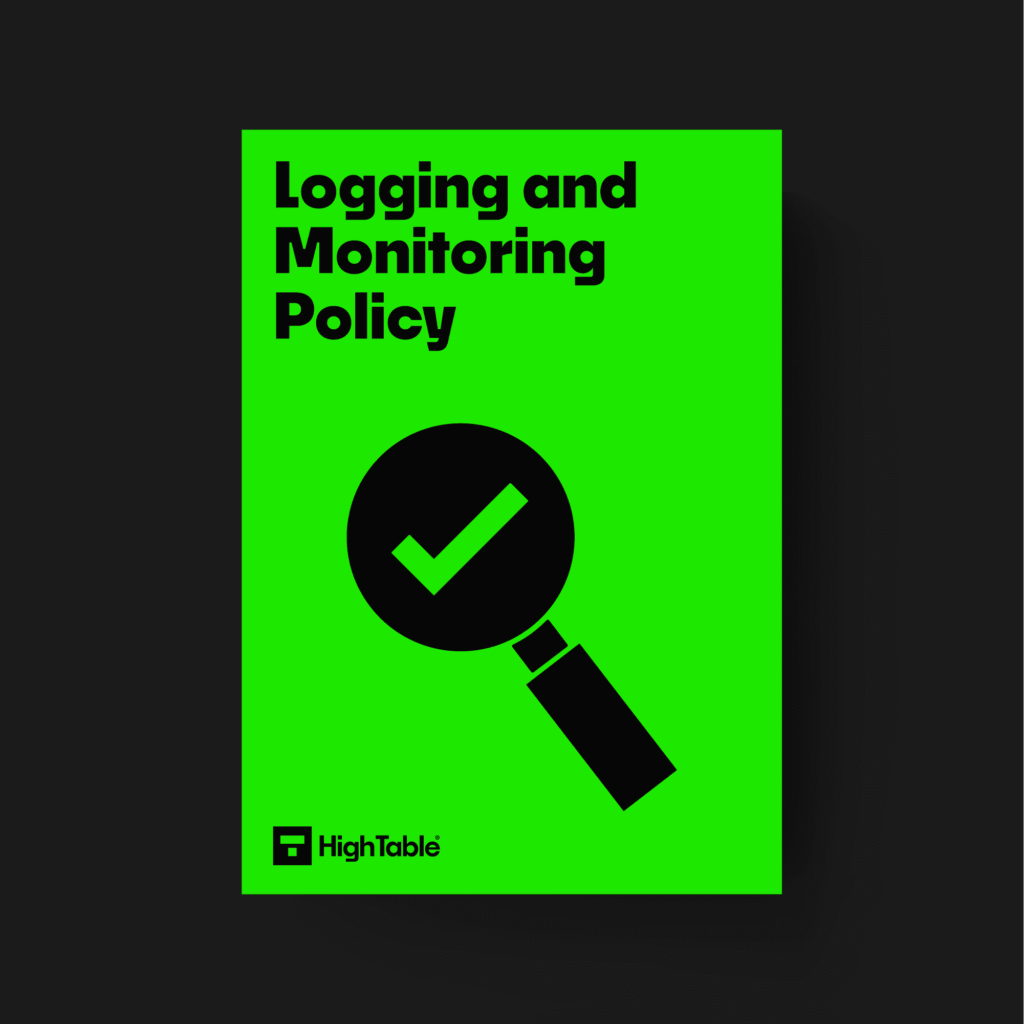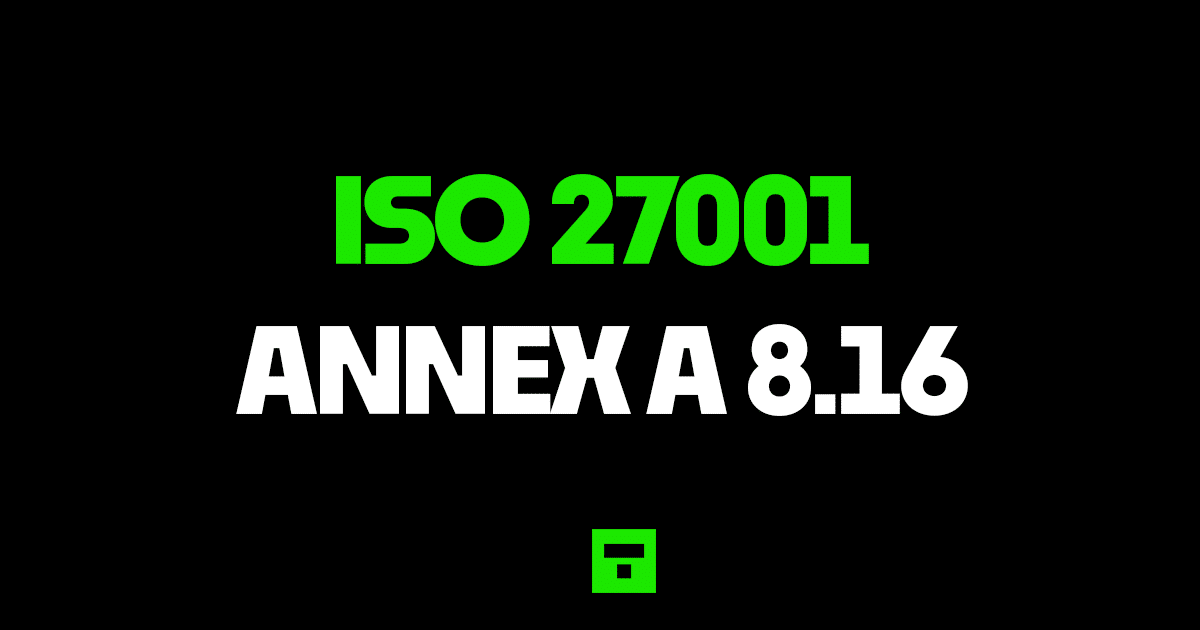Table of contents
What is ISO 27001 Monitoring?
ISO 27001 Annex A 8.16 Monitoring is an ISO 27001 control that requires to check for inappropriate actions on networks, systems, applications and premises. It is about checking before the bad things happen to try to catch them.
Purpose
ISO 27001 Annex A 8.16 is a detective control and corrective control to detect anomalous behaviour and potential information security incidents..
Definition
The ISO 27001 standard defines ISO 27001 Annex A 8.16 as:
ISO27001:2022 Annex A 8.16 Monitoring
Networks, systems and applications should be monitored for anomalous behaviour and appropriate actions taken to evaluate potential information security incidents.
Implementation Guide
Identify Requirements
Identify what requirements you have for monitoring so that you can understand what you need to implement.
This is going to be based on the risk assessments that you have conduct and the needs of the business and your clients.
Consider that we use monitoring to catch things either before or as they are happening and to support investigations if things do happen.
Topic Specific Policy
You will have a topic specific policy, the ISO 27001 Logging and Monitoring Policy that sets out what you do for logging and monitoring.

Monitoring Records
As with all logs and data you will need to define a data retention schedule for your monitoring records and put in place appropriate safeguards, protections and information security controls, as with any other data.
What to monitor
What you monitor is down to you and your identification of requirements but the standard provides some guidance on typical things that can be monitored being:
- Traffic that is inbound and outbound
- Access to resources
- Critical configuration files
- Security Tools Logs
- Event Logs
- Use of resource
Anomalous behaviour
Our monitoring is looking for behaviour outside the norm. Examples include:
- Processes or applications that just stop, or restart
- Malware traffic
- Unusual system behaviour
- Bottlenecks or spikes in resource usage
- Unauthorised scans of systems and networks
- Access attempts on restricted resources
Ensure You Meet the Laws
Monitoring is potentially dangerous when it comes to law and regulation, in that it can contain information and data protected by data protection laws and others. It is important to ensure that what you have and what you do complies. This is includes all steps of the process and lifecycle. It is recommended to get the advice of legal and data protection professionals in terms of your particular deployment.
Monitoring Tools
The use of monitoring tools is clearly recommended. Some of these are built into to systems and operating systems and some are off the shelf, dedicated solutions. It maybe that you have a hybrid of tools. They need to be able to handle large volumes of information and include real time notifications. Alerts should be configured and implemented and set against pre defined thresholds.
Monitoring is usually done be specialist software with examples being Host Intrusion Detection Systems (HIDS) or Network Intrusion Detection Systems (NIDS).
Staff
Staff will be trained to be able to use tools and interpret the information and appropriately respond. This can include the management of false positives, which do happen.
Continuous Monitoring
The standard advocates for continuous monitoring, in real time or at periodic intervals.
ISO 27001 Templates
DO IT YOURSELF ISO 27001
All the templates, tools, support and knowledge you need to do it yourself.
ISO 27001 templates have the advantage of being a massive boost that can save time and money so before we get into the implementation guide we consider these pre written templates that will sky rocket your implementation. This ISO 27001 Toolkit has been specifically designed so you can DIY your ISO 27001 certification, build your ISMS in a week and be ISO 27001 certification ready in 30 days.
How to comply
To comply with ISO 27001 Annex A 8.16 you are going to implement the ‘how’ to the ‘what’ the control is expecting.
In short measure you are going to:
- Understand and record the legal, regulatory and contractual requirements you have for data
- Conduct a risk assessment
- Based on the legal, regulatory, contractual requirements and the risk assessment you will implement a monitoring solution
- Implement a topic specific policy, the ISO 27001 Logging and Monitoring Policy
- Document and implement your processes and technical implementations for monitoring
- Check that the controls are working by conducting internal audits
What will an auditor check?
The audit is going to check a number of areas. Lets go through the main ones
That you have documentation
What this means is that you need to show that you have documented your legal, regulatory and contractual requirements for information and that you have taken this into account when building your monitoring solution. Where data protection laws exist that you have documented what those laws are and what those requirements are. That you have an information classification scheme and a topic specific policy for access control and that you have documented your monitoring taking all of this into account.
That you have have implemented monitoring appropriately
They will look at systems to seek evidence of monitoring. They want to see evidence of monitoring and the process in operation that includes the analysis of the monitoring data and what you do as a result of that analysis. In addition the use of cloud services and the cloud providers monitoring and monitoring capabilities will be reviewed.
That you have conducted internal audits
The audit will want to see that you have tested the controls and evidenced that they are operating. This is usually in the form of the required internal audits. They will check the records and outputs of those internal audits.
Top 3 Mistakes People Make
In my experience, the top 3 mistakes people make for ISO 27001 Annex A 8.16 monitoring are
You collect too much
Collecting too much data and logging everything is a common mistake we see. That in conjunction with storing all logs for ever. It is easy to be overwhelmed with information so it is important to work out what you are going to log and why. Then to be sure that the information is valuable, can be analysed and that analysis is actionable.
You don’t know your legal obligations
This is a massive mistake that we see, where people assume ISO 27001 is just information security and forget that it also checks that appropriate laws are being followed, and in particular data protection laws. Cost saving by not having a data protection expert or ignoring data protection law entirely is a common mistake we see people make when cutting corners and saving costs. Monitoring and in particular personal information, can get you in a lot of hot water depending how you implement it.
Your document and version control is wrong
Keeping your document version control up to date, making sure that version numbers match where used, having a review evidenced in the last 12 months, having documents that have no comments in are all good practices.


